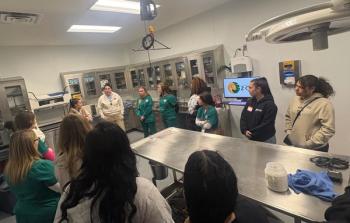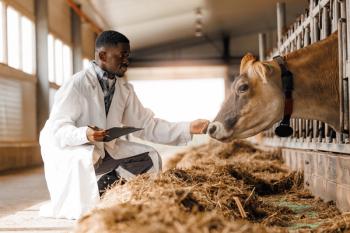
Fast forward for veterinary school
The University of Arizona is exploring a veterinary school that's faster with more intensity. If the plan passes, students could obtain a degree in four or five years instead of eight-and potentially halve their debt.
Eight years. Four hundred sixteen weeks. Two thousand, nine hundred and twenty days. That’s the average time it takes a student to make the journey from high school graduate to doctor of veterinary medicine. Now imagine taking that trip in roughly half the time. Would it work?
The University of Arizona thinks so, and it’s asking its state to fund an initial $250,000 study to find out. Shane Burgess, BVSc, PhD, is a veterinarian, vice provost and dean of the University of Arizona’s College of Agriculture and Life Sciences. He’s taken the university’s plan to House and Senate committees. If the Legislature includes money for the study in this year’s budget, Burgess would like to complete the economic study in time for the next legislative session.
“We’re looking at a model that will decrease the cost of a degree dramatically and also be a positive economic stimulus to the state’s economy. So everybody wins,” Burgess says. “If the study shows our plan works and makes sound business sense, we’ll pursue it, and if not, we won’t.”
Three factors are driving the University of Arizona’s plan. The first is its concern that every veterinary student in Arizona becomes an out-of-state student. Burgess says that’s the most expensive way to become a veterinarian. “The total direct costs for an Arizonan to obtain a veterinary degree are between $225,000 and $250,000 from high school to qualification,” Burgess says.
A small fraction of these students receive state assistance, which means the government is sending that money out of state. Plus, the state is not generating the revenues it could be by having its own veterinary education program. “So we believe not only is this good to decrease the students’ cost, but it will also be an economic driver for the state of Arizona,” Burgess says.
The second factor, Burgess says, is the mismatch in the veterinary profession between salaries and the cost of education—which they plan to address by decreasing the time it takes a student to obtain a degree. The third driver is the need to create a program that broadens veterinary students’ focus to include opportunities beyond companion animal medicine, such as bioeconomy, food safety, border safety and large animal medicine, Burgess says.
Almost all the infrastructure needed for the school exists already. Burgess says the university’s multimillion-dollar research program, medical school, public health school, pharmacy school and the multiple farms and ranches the university owns would easily allow the school to add a veterinary college. “We are confident, based on other models doing this on a similar time frame that are also AVMA-accredited—and we have talked to the AVMA already—that we will be able to find a way within our system,” Burgess says. “Now, we may be wrong, and if that’s the case, we won’t go any further. But I don’t suspect we’ll be wrong.”
One degree at a time
The plan the University of Arizona is proposing isn’t a new approach. Colleges like Massey University in New Zealand, an AVMA-accredited program where Burgess obtained his veterinary degree, offer five-year or 10-semester programs to receive a bachelor of veterinary science (BVSc) degree. Using a similar approach at the University of Arizona, students could complete undergraduate coursework in one to two years. If admitted to the College of Veterinary Medicine, they could complete their veterinary degree in three years if the program runs year-round, without a summer break.
Noble Jackson, DVM, is an associate professor of practice with the Department of Veterinary Science and Microbiology at the University of Arizona. He says the length of time it takes to obtain a veterinary degree is a national issue. A typical veterinary student spends eight years in school to get her doctorate in veterinary medicine, he says, and most of the schools are publishing statistics that show the average graduate owes $130,000 to $140,000.
“That’s a tough debt load when you compare that to starting salaries in practice, in the $60,000 to $70,000 range,” Jackson says. “In a way, that part of the veterinary training system is broken. The market forces out there that offer salaries for these students aren’t going to immediately increase those salaries. So we’ve got to look at how can we get students educated in a quicker amount of time with less debt.”
Undergraduates enrolled in food safety and microbiology at the University of Arizona learn how to conduct microbial analyses on various food products. Photo by John Marchello/Courtesy of the University of Arizona.
About 40 years ago, students didn’t need to obtain a four-year undergraduate degree to be eligible for veterinary medical school, Jackson says. And internationally, they still don’t. The change from veterinary school candidates obtaining two-year to four-year undergraduate degrees may have been dictated by the high level of competition among applicants for places in veterinary school, he says. Now most U.S. students go to school four-plus years before they’re admitted to veterinary school, he says.
“Realistically, that’s too long,” Jackson says. “They don’t need to have a bachelor’s degree to become a veterinarian. So our plan is designed to cut that time down significantly. Our plan could get students through the classes we think are important in two years. That’s going to require a pretty science-intensive undergraduate education, but if we go back 40 years in time, that’s what was done.”
Jackson says cutting off two years of undergraduate school will likely save the average student at least $25,000 a year, going by the cost of undergraduate education in Arizona. Plus, the Arizona plan proposes following the model of many international veterinary schools and running the program year-round, without summer breaks. While this wouldn’t actually lower tuition costs, it could save students a year’s worth of living expenses.
Jackson says that by cutting two years of undergraduate expenses and a year of living expenses in veterinary school, students could save anywhere from $60,000 to $70,000, which is right around half of what’s quoted nationally for veterinary student debt. “By doing this, we wouldn’t cut down the quality of education, we’d just cut down the time frame involved with getting that degree,” Jackson says. In addition, this program would put graduates in the workplace sooner, which in turn could do more to improve their earning power.
“Lifetime earnings could easily go up a couple hundred thousand compared to the system we have currently in the United States,” Jackson says.
Another novel element of the University of Arizona plan is that it does not include a teaching hospital. Instead, students would be distributed to private veterinary practices in the state to meet residency requirements.
“I personally think it’s a very good way to educate students,” Jackson says. “One, you’re putting them out in the real world—not to say academia isn’t the real world. But in reality, students who go through the traditional system see cases that are referred to their hospital. Whereas in the private practices, in the feed lots, they’re actually seeing the common cases an average veterinarian would see.”
Another advantage of the distributive model, Jackson says, is that the school could send students to areas where they see potential veterinary jobs. These might include the biomedical industry and animal research activities. “In a university like ours with a medical school, there’s a lot of research going on that veterinarians are already involved in,” he says. “We have tremendous assets here on campus. We’ve got an actual working ranch as part of the college, we’ve got a feed lot here, we’ve got the animal research center that’s already doing work with the medical school. And we’re situated in a unique spot in the United States. We’re sort of a sentinel for any potential foreign animal diseases that might come north to the United States. And there’s a tremendous amount of agriculture that’s going on currently in Mexico that crosses back and forth to the United States.”
Room for more?
If the University of Arizona’s plan goes through, the earliest veterinary students would be admitted would be August 2015. But by then, it might not be the only veterinary school in the state. Midwestern University, a private, not-for-profit university that focuses on healthcare education, announced plans to open a veterinary medical school in Arizona with an inaugural class of 100 students in 2014.
Kathleen Goeppinger, PhD, is the president and CEO of Midwestern University. She says the school features 19 different masters and doctorate-level health sciences programs across the nation. “We feel the true picture of healthcare includes veterinarians and the One Health concept,” Goeppinger says. “There is not a veterinary school in the state of Arizona at this time. And we feel that by bringing in a class and having them look toward rotations in rural areas and other areas that are short veterinarians, we will help the population. We also think there’s so much synergy in research between veterinarians and our other scientists that it’s a very strong linkage.”
Midwestern is committing about $120 million to build the facilities and hire faculty and an administrative team. “We spent at least two full years investigating before we made the decision to have it approved by our board of trustees,” Goeppinger says. “Our driving factor was the ability to expand the healthcare team, but we also knew that the state did have a shortage.”
However, Midwestern’s new school has not influenced the University of Arizona’s plans to investigate a college of veterinary medicine, Burgess says.
“Every state that has more than one veterinary school—and in most cases that’s private and public—is benefitting from those two entities,” he says. “Midwestern’s plan hasn’t changed anything we’re thinking of doing.”
Giovanna Martinez, a research technician in the bacteriology section of the Arizona Veterinary Diagnostic Laboratory at the University of Arizona, examines a bacterial culture plate. Photo by Sara Plevel/Courtesy of the University of Arizona.
A veterinary shortage?
In 2012, the National Academy of Sciences released its “Workforce Needs in Veterinary Medicine” report. The study identifies no personnel shortages in veterinary medicine. But many Arizonans disagree, citing underserved rural areas of the state.
Midwestern University points to an American Association of Veterinary Medical Colleges projection that there will be a shortage of 15,000 veterinarians over the next 20 years (a 10-year-old report many experts have questioned considering more recent research). Perhaps to confuse matters further, the U.S. Bureau of Labor Statistics (BLS) predicts 36 percent growth in the employment of veterinarians from 2010 to 2020—a much-faster-than-average growth rate for all occupations. (But again, many of those within the veterinary field have questioned the BLS’s methodology and results.)
The debate doesn’t end there. Research indicates that a key reason for open jobs in large animal medicine is that the jobs don’t offer enough financial compensation. A 2011 report from American Association of Bovine Practitioners indicates these areas of underserved rural America exist because it’s not financially feasible to make a living in these parts of the country.
Goeppinger says that when Midwestern was exploring the idea of launching a veterinary school, she met with some of the people representing the various animal groups, including members of the cattlemen’s association and state senators from rural areas, who reported they did find a shortage of veterinarians in their areas.
While Goeppinger says it’s too early in the school’s planning stages for her to comment on potential tuition costs and student debt loads for veterinary students, the school has explored whether it’s possible to offer students incentives to serve in rural areas. And she says the university will use its established team of counselors to help with financial aid and encourage students to keep their student debt as low as possible.
“I saw the article in The New York Times [about veterinary student debt], and I’ve read a lot of position papers on this. I think that if you help manage the student’s burden, it becomes a much more doable project for them to pay back their loans,” Goeppinger says.
Mark Killian, a 14-year veteran of the Arizona state Legislature and a member of the Arizona Board of Regents, says the system has to change to make jobs in rural areas of the state viable. He supports the University of Arizona’s plan for a veterinary school, due in large part out of concerns about biosecurity.“My big concern, looking beyond Arizona, is that we’re going to wake up with a shortage of large animal veterinarians in the next 15 years,” says Killian, who is a managing partner in family ranching operations in Arizona and New Mexico. “Because of biosecurity, I think rural America is going to be in big trouble. We need to focus on trying to create as many large animal veterinarians as possible—we’ve got plenty of small animal veterinarians.”
Jackson and Killian agree that these jobs may be more viable for new graduates if they’re starting out their careers with less debt. And Burgess says one of his goals is to make it more financially feasible to be a working veterinarian. “The question of whether it’s economically viable is not something I can control,” he says. “But I can contribute to making it more economically viable.”
Killian says a key is to drive down the cost of all college tuition. “Saddling students with all this debt is unconscionable,” he says. “It’s not only a state problem, it’s a national problem. And it’s something we’re going to have to deal with. It makes no sense to me to have these young people come out of college with hundreds of thousands of dollars of indebtedness. It’s just not right.”
He would also like to see veterinary graduates incentivized to go into large animal medicine. Killian served in the Arizona Legislature from the early ’80s to the middle ’90s and recalls several states using incentives to encourage medical students to locate in rural areas after their residencies. He says these programs might be a starting point to develop similar programs in veterinary medicine.
“It would require an act of the Legislature to do that, and again it gets back to the biosecurity of our food products,” he says. “People need to wake up and understand that’s a very important thing and it is something we need to pursue.”
Killian says he’s frustrated that Americans haven’t created more publically owned veterinary schools. Because of the resulting competition making it more expensive to get into veterinary school, “I think we’ve precluded a lot of kids in the rural areas who normally may have been able to go to veterinary school,” he says. “I think we lost out on a lot of potential veterinarians.”
Newsletter
From exam room tips to practice management insights, get trusted veterinary news delivered straight to your inbox—subscribe to dvm360.






